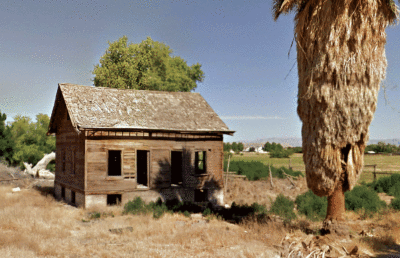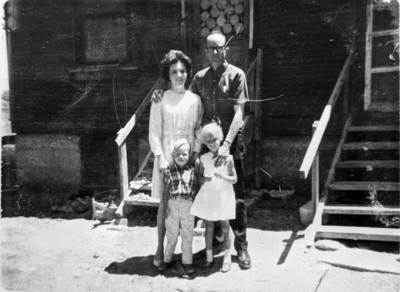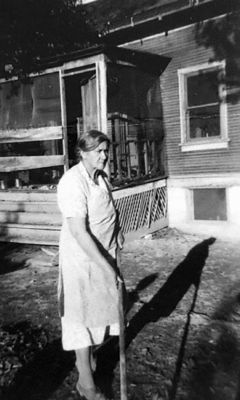This is the second in a two-part series relating history of the Rice house, an historic building in Logandale which was recently demolished. Click here for Part One
By VERNON ROBISON
The Progress

To the eyes of most folks, it was just an old abandoned building. Yet it had stood on the east side of Rice Road in Logandale, just south of the old Overton irrigation ditch, for more than a hundred years.
Then last month, suddenly, the old house wasn’t there anymore. Today, nothing remains of the old Rice House. Without much fanfare at all, one of the oldest houses in the Moapa Valley met its end – and with it a long-standing reminder of the Moapa Valley’s early history.
What follows is memories of living neighbors and family members who recall visiting the Rice House and can give first hand accounts of what it was like, and who the people were that lived in it.
Neighborhood kids
Logandale resident Bryant Robison, who is now 89 years old, was one of the closest neighborhood kids to the Rice family. Bryant was good friends with John Rice and spent a lot of time playing in and around the Rice house and in the fields in between the two boys’ homes.

Remembering back to his childhood in the late 1930s and 1940s, Bryant said that the Rice house was already an old pioneer house even at that time.
“From when I was just a little kid it was just an old house,” Bryant said. “It never had any running water and it never had any electricity, even well after those things had become available in the valley.”
To provide some water to the house, there was a sistern, an underground concrete storage tank. About 5-6 feet deep, the cistern was on the north side of the house where it could be filled by the nearby ditch water. Whatever sediment was in the water would settle to the bottom of the cistern in time. Then the clearer water could be drawn out for household use.
“There was a hand pump in the kitchen, which was really kind of a covered back porch,” Bryant said. “You pumped it with a lever, and that was all the water that they had in the house.”
Overton resident Emma Lu Whipple Lewis, who grew up just up the street from the Rices and was a playmate to youngest daughter Fern Rice, recalled an interesting neighborly interaction occuring between her mother and Priscilla Rice, Fern’s mother.
At that time, the Whipples already had running water into their house for bathing and cleaning. But not recalling that, one dayPriscilla came and urgently told Mrs. Whipple that she really must hurry. There was only one water sprinkling can left at Bill Cooper’s store in Logandale, she said.

At that time, Cooper’s General Store was located in the present day Pirate’s Landing restaurant building.
Priscilla told Mrs. Whipple, that she had already tried the watering can from the store and it worked very well.
“Mom was a bit confused about that and asked ‘Works well with what?’,” Emma Lu recalled with a smile.
“Priscilla told her, ‘Well Henry A. (her oldest son), he is taller and I have to stand on a chair when I give him his shower. But I can use that watering can to pour it on his head while he cleans himself off. And then we just go one by one through everyone.’ She said that the watering can sure had helped a lot to get everyone in the family bathed.’”
Good neighbors
Emma Lu remembered the Rices being excellent neighbors. She recalled a time when her younger brother Alma was a newborn baby. One night he wasn’t feeling well and was crying loudly late into the night. His mother tried to comfort him to no avail.
After a long time of this racket, Henry, Jr. showed up at their house and said, “Give me that kid!”
“Mom said, ‘No, Henry, it is okay. You go back and get some rest. You need your sleep.’,” Emma Lu recalled. “And he said, ‘Well, who the hell can sleep with that baby crying?!’”
Henry then took baby Alma and gently walked up and down the lane with him so that his mom could get some rest. He finally got him asleep and brought him back to his bed.
Emma Lu remembered that Priscilla often spent most of the day at the Whipple home.
“They had no power down there, so she would just come up and spend all day sitting at our house, doing embroidery,” Emma Lu said. “But she was a welcome guest. She was always a good friend to my mom.”
Emma Lu noted that the Rices never had an automobile. Neither Priscilla nor Henry Jr. were very interested in driving. So they would walk everywhere they needed to go; or get a ride from a friend.
“She would walk all over the place,” Emma Lu said of Priscilla. “She always wore these long cotton, dark socks that came all the way up; and a dress, of course, and a large hat. And she always wore a sweater even in the heat of summer. I don’t know how she did that!”
Summertime Visits
Logandale resident Esther Ramos remembers coming to visit the Rices as a young child on family vacations during the late 1950s and early 1960s. Her family lived in Texas at the time.
Esther is the granddaughter of Marguerite Lyman, youngest daughter of Henry Rice, Sr.. Marguerite lived just down the street and around the corner in Logandale. So the Rice house was a common family gathering spot during their visits.
Esther recalled that her family never visited during the cooler times of the year. Only during the hot months of summer vacation.
“Of course there was no power to the house, so it was always very hot in there, very hot!” she said. “And it was always crowded and noisy; and it always smelled really bad in there. I don’t know why.”
“I have always had trouble with crowded quarters like that,” Esther added. “So I would usually go outside and look for a quiet hiding spot.”
She found the empty water cistern to be a cool place to find some solitude. “I spent most of the time out there,” Esther said.
But she was never forgotten out there. Priscilla would always show the young Esther kindness and bring food out to her out in her hiding place.
“Priscilla knew I was there somehow and she made sure I was taken care of,” Esther said. “I don’t think she ever told my mother that is where I was because my mother would have come and dragged me in with everyone else even though I wouldn’t fit.”
Esther also remembered that the kitchen of the home was little more than a covered back porch on the east face of the house. She recalls there being a large wooden box on the porch with two small doors. In the top compartment, the family put a large block of ice obtained from the packing plant near the railroad. In the bottom compartment, they put food items that needed to keep cool.
“There was a drip pan underneath to be emptied as the ice melted,” Esther said. “That is what they had for a refrigerator”
The grandkids’ memories
Joan Kirby is a granddaughter of Henry and Priscilla and oldest daughter of Fern Rice Barber. She remembers, as a child, coming to the house for a visit in 1969. This was well after Henry had died and Priscilla was still living in the old house.
“I seem to remember at that point that there were electric lights strung to the rooms, but that the wires were visible,” Joan said. “So I think that there was some electricity there in the final years that my grandmother was in it.”
Joan, who now lives in Kanab, Utah, also remembers earlier times when there was no electricity in the house. “Their only lights were kerosene lamps,” she said. “That is the way my mother grew up.”
Joan chuckled to remember the year after she graduated high school. She brought home a pair of oil lamps.
“I walked in the door and my mom looked at them and said ‘What in the world? Why did you buy those?’” Joan said. “I replied that I thought they were beautiful.
“Mom said, ‘No, they’re not! If you had cleaned as many chimneys as I have, you would not think they were beautiful either!’”
Joan also remembered that her grandmother was very creative. She fondly recalled Priscilla’s rock gardens that were carefully fashioned in the front yard and on the porch of the house.
“As a kid, it was a magical place because she had all these little creations out there,” Joan said. “There were little buildings and so forth that she had made with rocks and broken glass. It was beautiful to a child.”
Joan’s younger brother Ted, also remembers visiting the old house during trips from their home in Tucson, Arizona. He said that it was a strange place for a young child to visit.
“There was no electricity so we would go to bed right after sundown,” Ted remembered. “There was no running water so it was weird for a little boy. I was used to having those things at home.”
“I also remember that the house smelled kind of different,” Ted added. “I don’t know, maybe it was just from how old it was; or maybe because they had burning lamps for so long in there. Anyway, it just smelled kind of different for a little boy.”
But Ted had fond memories of his grandmother. “She was loved by the children in Logandale and she was very kind to everyone she met,” he said. “She loved animals, especially birds; and she knew how to make all the bird calls and could name all the types of birds in the area.”
Ted recalled that Priscilla created handmade toys and quilts as gifts for her children and grandchildren.
“She also wrote beautiful poetry and she made books of poetry for family and friends,” he said.
Ted added that he still is in possession of the old skeleton key used to unlock the front door of the house. It was given to him years ago by his mother.
“I understand why the house was torn down,” Ted said. “But I would have loved to be able to go through it once more. Maybe the doorknob and locking mechanism was still around, or something; to go with the key. That would have been nice.”
At some point in the early 1970s, Priscilla would finally move out of the old home leaving it vacant and abandoned.
She moved to a small house that had been prepared for her on a little angular lot just south of the Logandale bridge on the east side of the highway, right next to the current day Valley Pediatric Dental office. The little home had water and power hookups.
Priscilla lived there until 1977 when she passed away.
Editor’s Note: This series was written by drawing on a variety of different historical source material. A history of Henry Rice Sr., written in the 1960s by his daughter Marguerite Rice Lyman was chief among these sources. Also the local history book “Moapa Valley Reflections” by Beezy Tobiasson and Georgia Hall had a number of important sources. I also appreciate the help of Fern Rice Barber’s children who scoured their family records, and their own early memories, looking for photos and other documents. Finally, a thanks to those who spent time recalling their past experience in live interviews.








![ElectionAd [Recovered]2](https://mvprogress.com/wp-content/uploads/2024/05/4-24-2024-FC-ElectionAd-Finalv3.jpg)


2 thoughts on “Fond Memories of an Iconic Family Home in M.V., Part 2”
Thank you for the great reminder of a remarkable woman. I have fond memories as a young boy of being with my Grandmother (Lillian Pulsipher) when she would visit Priscilla Price. My Grandmother too would walk to any location in the valley at any time she felt she could assist whether the help was wanted or not.
I had forgotten about the knee high socks Priscilla would wear but could never forget the over size hats she wore for shade. For a time in the early 70’s, we were neighbors to the Rice home. We rented the Whipple house while my father was building our first Logandale home located on Sandy Lane. I must admit that as a young boy, I was terrified of the old Rice home but later was mesmerized by it and wanted to live there “someday.”
I’m grateful to have known these two wonderful examples of strong, faithful and caring woman. I appreciate you bringing back these cherished memories to me.
I love the stories and the history of the people and places of the valley. Please continue to include these articles. I love and miss the valley and all the great people there. Thank you Vernon for your research, effort and talents.